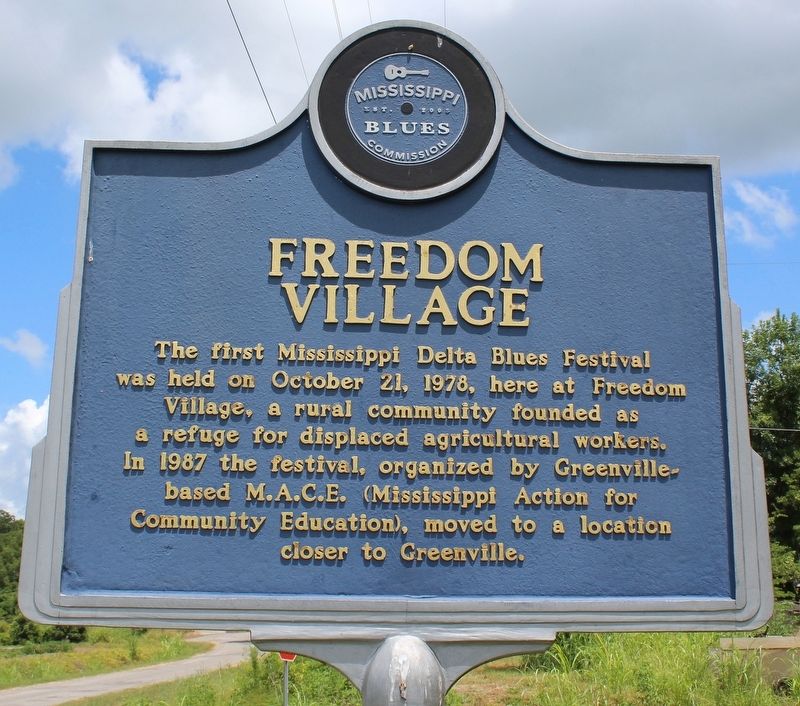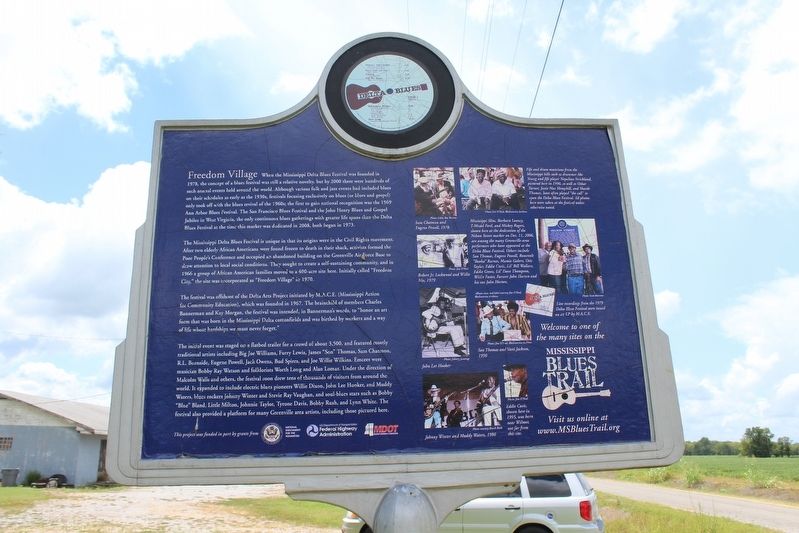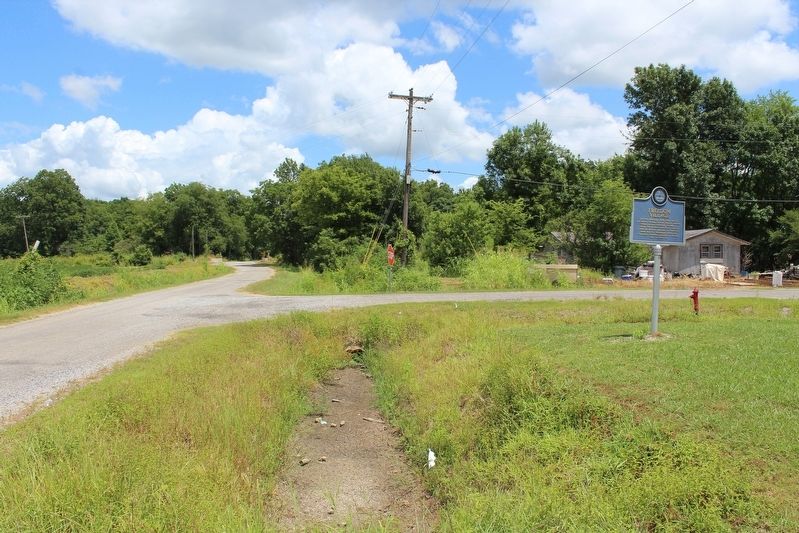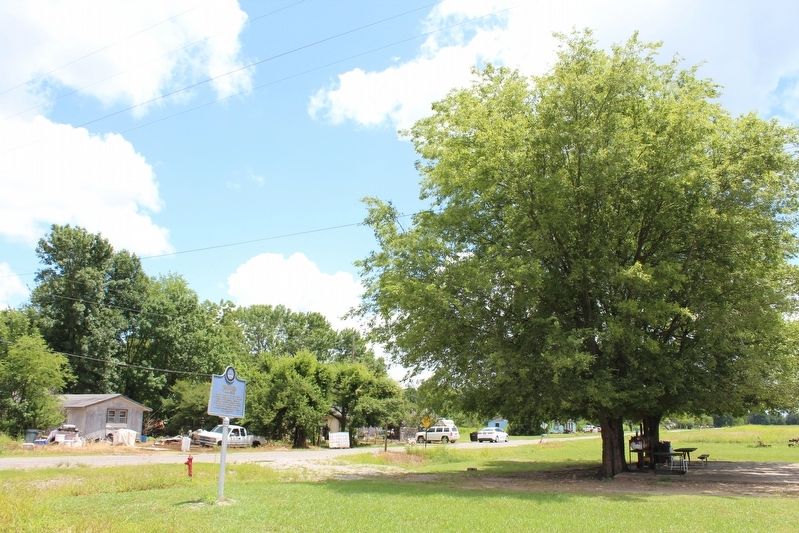Near Greenville in Washington County, Mississippi — The American South (East South Central)
Freedom Village
The first Mississippi Delta Blues Festival was held on October 21, 1978, here at Freedom Village, a rural community founded as a refuge for displaced agricultural workers. In 1987 the festival, organized by Greenville-based M.A.C.E. (Mississippi Action for Community Education), moved to a location closer to Greenville.
(Back)
Freedom Village When the Mississippi Delta Blues Festival was founded in 1978, the concept of a blues festival was still a relative novelty, but by 2000 there wree hundreds of such annual events held around the world. Although various folk and jazz events had included blues on their schedules as early as the 1930s, festivals focusing exclusively on blues (or blues and gospel) only took off with the blues revival of the 1960s; the first to gain national recognition was the 1969 Ann Arbor Blues Festival. The San Francisco Blues Festival and the John Henry Blues and Gospel Jubilee in West Virginia, the only continuous blues gatherings with greater life spans that the Delta Blues Festival at the time this marker was dedicated in 2008, both began in 1973.
The Mississippi Delta Blues Festival is unique in that its origins were in the Civil Rights movement. After two elderly African Americans were found frozen to death in their shack, activists formed the Poor People’s Conference and occupied an abandoned building on the Greenville Air Force Base to draw attention to local social conditions. They sought to create a self-sustaining community, and in 1966 a group of African American families moved to a 400-acre site here. Initially called “Freedom City”, the site was incorporated as “Freedom Village” in 1970.
The festival was offshoot of the Delta Arts Project initiated by based M.A.C.E. (Mississippi Action for Community Education), which was founded in 1967. The brainchild of members Charles Bannerman and Kay Morgan, the festival was intended, in Bannerman’s words, to “honor an art form that was born in the Mississippi Delta cottonfields and was birthed by workers and a way of life whose hardships we must never forget.”
The initial event was staged on a flatbed trailer for a crowd of about 3,500, and featured mostly traditional artists including Big Joe Williams, Furry Lewis, James “Son” Thomas, Sam Chatmon, R.L. Burnside, Eugene Powell, Jack Owens, Bud Spires, and Joe willie Wilkins. Emcees were musician Bobby Ray Watson and folklorists Worth Long and Alan Lomax. Under the direction of Malcom walls and others, the festival soon drew ten of thousands of visitors from around the world. It expanded to included blues pioneers Willie Dixon, John Lee Hooker, and Muddy Wters, blues rockers Johnny Winter and Stevie Ray Vaughan, and soul-blues stars such as Bobby “Blue” Bland, Little Milton, Johnnie Taylor, Tyrone Davis, Bobby Rush, and Lynn White. The festival also provided a platform for many Greenville area artists, including those pictured here.
(captions)
Sam Chatmon and Eugene Powell, 1978.
Fife and drum musicians from the Mississippi hills such as drummer Abe Young and fife player Napolian Strickland, pictured here in 1990, as well as Othar Turner, Jessie May Hemphill, and Sharde Thomas, have often played the “the call” to open the Delta Blues Festival All photos here were taken at the festival unless otherwise noted.
Robert Jr. Lockwood and Willie Nix, 1979
Mississippi Slim, Barbara Looney, T-Model Ford, and Mickey Rogers, shown here at the dedication of the Nelson Street marker on Dec. 11, 2006, are among the many Greenville-area performers who have appeared at the Delta Blues Festival. Others include Son Thomas, Eugene Powell, Roosevelt “Booba” Barnes, Mamie Galore, Otis Taylor, Eddie Cusic, Lil’ Bill Wallace, Eddie Green, Lil’ Dave Thompson, Willie Foster, Farmer John Horton and his son John Horton.
John Lee Hooker
Son Thomas and Vasti Jackson, 1990
Live recording from the 1979 Delta Blues Festival were issued on an LP by M.A.C.E.
Johnny Winter and Muddy Waters, 1980
Eddie Cusic, shown here in 1995, was born near Wilmot, not far from this site.
Erected 2008 by Mississippi Blues Commission. (Marker Number 50.)
Topics and series. This historical marker is listed in these topic lists: African Americans • Arts, Letters, Music • Entertainment. In addition, it is included in the Mississippi Blues Trail series list. A significant historical date for this entry is October 21, 1978.
Location. 33° 18.771′ N, 90° 57.469′ W. Marker is near Greenville, Mississippi, in Washington County. Marker is at the intersection of Sligo Diary Road and Freedom Village Road, on the right when traveling east on Sligo Diary Road. Touch for map. Marker is in this post office area: Leland MS 38756, United States of America. Touch for directions.
Other nearby markers. At least 8 other markers are within 8 miles of this marker, measured as the crow flies. Belmont Plantation (approx. 5.3 miles away); Birthplace of Kermit the Frog (approx. 7.1 miles away); Deer Creek (approx. 7.2 miles away); Johnny Winter (approx. 7.3 miles away); Corner of 10 and 61 (approx. 7.3 miles away); James “Son” Thomas (approx. 7.3 miles away); Ruby's Nite Spot (approx. 7.3 miles away); "Little Italy" (approx. 7.3 miles away).
Also see . . . Freedom City. The Mississippi Encyclopedia. (Submitted on August 15, 2020, by Tom Bosse of Jefferson City, Tennessee.)
Credits. This page was last revised on April 10, 2021. It was originally submitted on August 15, 2020, by Tom Bosse of Jefferson City, Tennessee. This page has been viewed 576 times since then and 78 times this year. Photos: 1, 2, 3, 4. submitted on August 15, 2020, by Tom Bosse of Jefferson City, Tennessee. • Bernard Fisher was the editor who published this page.



